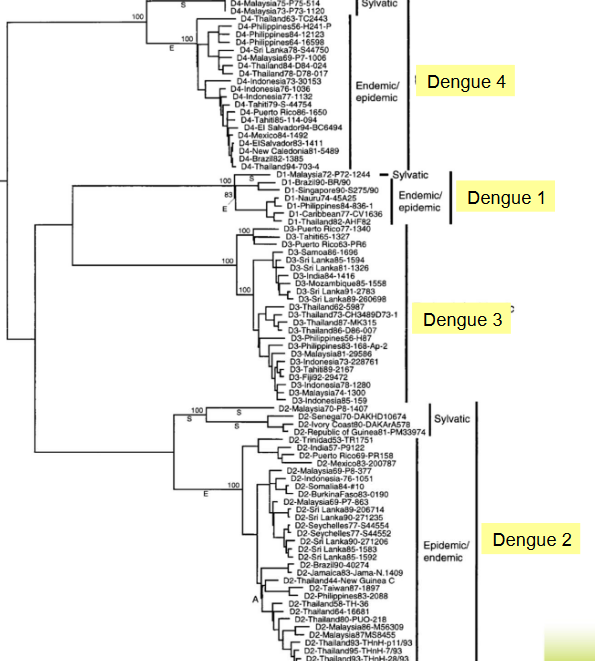2.2 Dengue Virus
Two to 14 days after one becomes infected with the Dengue virus, they begin developing a fever that lasts about a week.
The virus is then transmissible after a week.
Figure 2.5: Transmission Cycle of the Dengue (and the Chikungunya) Virus
It is believed that Dengue originally evolved in Asian forests:
Figure 2.6: Origin of the Dengue (and the Chikungunya) Virus
Dengue viruses belong to the genus Flavivirus (note the highlighted clades):

Figure 2.7: Phylogenetic Tree of Dengue Viruses
There are a total of four serotypes (i.e., clades). The viruses were believed to have evolved from sylvatic viruses (i.e., urban viruses).
2.2.1 Consequences of dengue
Figure 2.8: Countries at Risk of Dengue Transmission
The WHO estimates that around 40% of the world’s population lives in dengue-endemic regions. Furthermore, the organization also predicts that about 100 million contract dengue fever each year!
2.2.1.1 Dengue’s global situation
Figure 2.9: Rise in Dengue Cases Over the Years
Like figure 2.9 suggests, there is an increasing number of dengue cases each year. Furthermore, there are also a greater frequency and magnitude of outbreaks that result from 20000 to 40000 deaths each year.
Figure 2.10: Amount of Dengue-Stricken Patients by Country
Given the content mentioned at the beginning of this sub-chapter, figure 2.10 makes sense.
2.2.1.2 Economic consequences of dengue
2.2.1.2.1 In Singapore…
The disease was estimated to have costed Singapore anywhere between USD 0.85 billion to USD 1.15 billion in healthcare. 48% to 51% of that sum was due to (in)direct medical costs: for instance, lost productivity and the loss of household services.
42% to 59% of the latter sum of money was spent on vector control (i.e., mosquito spraying efforts).
2.2.1.2.2 In rural Cambodia…
Figure 2.11: Children Living in Rural Cambodia
Each dengue case costs around USD 30 to USD 105 to be treated. Because of this, about 67% of all households in Cambodia would have incurred an average debt of about USD 23.5 to finance the treatment of the illness.
For reference, the average household spends about USD 9.5 on food per week.
2.2.2 Drivers of dengue transmission
Figure 2.12: Breeding Environment of Aedes aegypti
Part of the reason why dengue is so prevalent in Singapore and other suburban environments is because the Aedes aetypti mosquito is able to breed on still (i.e., “dead”) water.
Figure 2.13: Greenery and Forests as Potential Dengue Hazards
The mosquito is also able to use greenery as breeding zones.
Figure 2.14: Global Trends that Encourage the Spread of Dengue
Figure 2.13 also displays some global trends that impacted the spread of dengue.
2.2.3 Male Aedes aegypti mosquitoes to reduce dengue vector populations in Singapore
Figure 2.15: Idea Behind Vector Control via Malef Breeding
The aim of this activity is illustrated in the above figure.
Figure 2.16: Decline in Mosquito Populations from Male Breeding